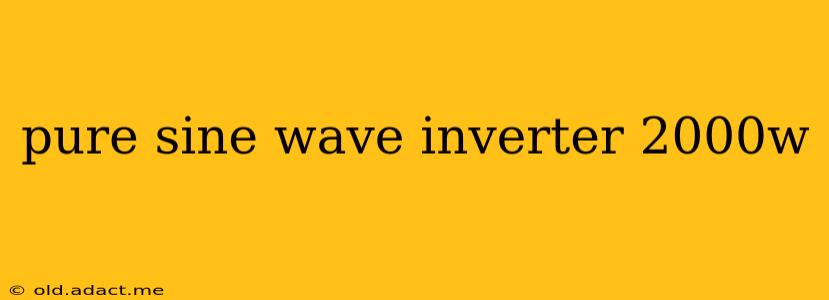A 2000W pure sine wave inverter is a powerful piece of equipment capable of running a wide range of appliances and electronics. But with so many options available, choosing the right one can feel overwhelming. This comprehensive guide will help you understand the key features, benefits, and considerations when selecting a 2000W pure sine wave inverter for your needs.
What is a Pure Sine Wave Inverter?
Before diving into the specifics of a 2000W model, let's clarify what a pure sine wave inverter is. Unlike modified sine wave inverters, which produce a less stable waveform, pure sine wave inverters generate a smooth, consistent AC power output that closely mimics the electricity supplied by your home's power grid. This is crucial for sensitive electronics like computers, laptops, televisions, and medical devices. These devices can malfunction or be damaged by the less-refined power produced by modified sine wave inverters. A 2000W pure sine wave inverter ensures reliable and safe operation for these sensitive loads.
Why Choose a 2000W Pure Sine Wave Inverter?
A 2000W inverter offers significant power capacity, suitable for powering a variety of devices simultaneously. You can run multiple appliances without overloading the inverter, providing flexibility and convenience. This power level is ideal for:
- Home backup power: Running essential appliances during a power outage.
- Off-grid living: Providing power in remote locations.
- RV and camping: Powering various recreational equipment.
- Construction and industrial applications: Running power tools and equipment.
What to Consider When Buying a 2000W Pure Sine Wave Inverter
Several factors should be considered before purchasing a 2000W pure sine wave inverter:
Continuous vs. Surge Power:
Understand the difference between continuous and surge power. The 2000W rating usually refers to the continuous power output – the amount of power the inverter can consistently supply. The surge power rating indicates the maximum power the inverter can handle for short periods, typically when starting a motor-driven device like a refrigerator or power tool. Always check both ratings to ensure the inverter can handle the peak power demands of your appliances.
Input Voltage:
Inverter input voltage refers to the DC voltage source required to power the inverter (usually from batteries). Common input voltages are 12V, 24V, or 48V. Choosing the correct input voltage is crucial for compatibility and efficiency. Higher voltage systems (24V and 48V) are generally more efficient for higher-wattage inverters like the 2000W models.
Efficiency:
Inverter efficiency is measured as a percentage. A higher efficiency rating means less energy is wasted as heat, resulting in longer battery life and lower operating costs. Look for inverters with efficiency ratings above 90%.
Protection Features:
Essential safety features include overload protection, short-circuit protection, low-voltage shutdown, and over-temperature protection. These features prevent damage to the inverter and connected devices.
Waveform Quality:
While we've established the need for a pure sine wave, ensure the manufacturer's specifications confirm the purity of the output waveform. Look for specifications indicating Total Harmonic Distortion (THD) – lower THD values indicate a cleaner waveform.
Size and Weight:
Consider the physical dimensions and weight of the inverter, especially if portability is a factor.
H2: How Many Amps Does a 2000W Inverter Draw?
The amperage draw of a 2000W inverter depends on its input voltage. For a 12V system, the draw would be significantly higher than for a 24V or 48V system. You'll need to calculate this based on the specific inverter's specifications and the formula: Amps = Watts / Volts. Always consult the manufacturer's specifications to determine the exact amperage draw.
H2: What Size Battery Do I Need for a 2000W Inverter?
The battery size required depends on the power demands of your appliances and how long you need them to run. This calculation requires considering the inverter's efficiency, the runtime needed, and the battery's capacity (Amp-hours). It's best to consult a battery sizing calculator or seek advice from a qualified electrician to determine the appropriate battery bank size.
H2: Can I Use a 2000W Inverter with Solar Panels?
Yes, a 2000W pure sine wave inverter can be used with solar panels, but you'll need a charge controller to regulate the solar power input to the batteries. The size and configuration of the solar panel array will depend on your power requirements and sunlight conditions.
Conclusion: Choosing Your 2000W Pure Sine Wave Inverter
Selecting the right 2000W pure sine wave inverter requires careful consideration of your power needs, budget, and specific application. By understanding the key features, specifications, and safety considerations outlined above, you can make an informed decision and choose the best inverter to meet your requirements. Remember to always consult the manufacturer's specifications and, if needed, seek professional advice for complex installations or high-power applications.
